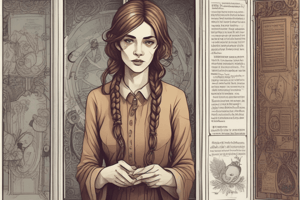Podcast
Questions and Answers
What is the main way to avoid plagiarism?
What is the main way to avoid plagiarism?
- Paraphrase the information
- Use a thesaurus to change words
- Synthesize multiple sources
- Cite your sources (correct)
Using an exact quote requires quotation marks around the original text.
Using an exact quote requires quotation marks around the original text.
True (A)
What should you do if it's not possible to rewrite the original author's idea?
What should you do if it's not possible to rewrite the original author's idea?
Use an exact quote with quotation marks.
What is a common misconception that writers have when trying to avoid plagiarism?
What is a common misconception that writers have when trying to avoid plagiarism?
Accidental plagiarism does not qualify as plagiarism.
Accidental plagiarism does not qualify as plagiarism.
What should you always include when using a source's exact words?
What should you always include when using a source's exact words?
Using __________ helps readers tell where you got your information quickly.
Using __________ helps readers tell where you got your information quickly.
When you write a more formal paper, what might you need to include?
When you write a more formal paper, what might you need to include?
What is plagiarism?
What is plagiarism?
What should Sylvia have done to avoid being accused of plagiarism?
What should Sylvia have done to avoid being accused of plagiarism?
Dave should have included a _______ to the website where he found the idea.
Dave should have included a _______ to the website where he found the idea.
Which of the following is a correct way to avoid plagiarism?
Which of the following is a correct way to avoid plagiarism?
Plagiarism can only occur when text is copied directly without any modifications.
Plagiarism can only occur when text is copied directly without any modifications.
Plagiarism is most commonly seen in _______ and online content.
Plagiarism is most commonly seen in _______ and online content.
What could happen to Sylvia if her plagiarism is discovered?
What could happen to Sylvia if her plagiarism is discovered?
What should you do to give proper credit when using a source?
What should you do to give proper credit when using a source?
Accidental plagiarism is still considered plagiarism.
Accidental plagiarism is still considered plagiarism.
Using _______ helps readers quickly identify the source of information.
Using _______ helps readers quickly identify the source of information.
Which method is NOT recommended for avoiding plagiarism?
Which method is NOT recommended for avoiding plagiarism?
Using a thesaurus to change every word is sufficient to avoid plagiarism.
Using a thesaurus to change every word is sufficient to avoid plagiarism.
What is the primary issue with Sylvia's article in the company newsletter?
What is the primary issue with Sylvia's article in the company newsletter?
What is the consequence Sylvia may face if her plagiarism is discovered?
What is the consequence Sylvia may face if her plagiarism is discovered?
What is one way Sylvia could have reworked the town history to avoid plagiarism?
What is one way Sylvia could have reworked the town history to avoid plagiarism?
Plagiarism is only considered when text is copied from printed sources.
Plagiarism is only considered when text is copied from printed sources.
Flashcards are hidden until you start studying
Study Notes
What is Plagiarism?
- Plagiarism is using someone else’s work as your own.
- It can include copying text from a website or taking an idea from a book without citing the source.
- It is common, and the internet has made it easier to plagiarize.
Example 1: Sylvia's Mistake
- Sylvia was tasked with writing an article about Shelbyfield.
- Sylvia copied several paragraphs from a website about Shelbyfield's history and pasted them into her article.
- She changed a few words to make it seem like her own work.
- This is wrong because she is taking credit for someone else's writing.
Example 2: Dave's Mistake
- Dave runs a home improvement blog.
- He sometimes gets ideas from other websites and writes blog articles based on those ideas.
- He does not cite the sources for these ideas.
- This is still wrong because he is taking credit for someone else's ideas.
Tips for Avoiding Plagiarism
- If you use a source, cite it.
- Cite sources to give proper credit to the original authors and help readers find the original source if they want to learn more.
- Use quotation marks when necessary to show that you are using another author's words.
- Do not simply change a few words or rearrange sentences to avoid plagiarism.
- Rewrite the information in your own words while still citing the original source.
- Synthesize the information by creating a unique perspective based on your sources.
How to Cite Online Sources
- For informal writing, like a blog, it is often sufficient to simply link to the original source.
- You can also mention the original author and website to help readers identify the source of the information.
- For formal papers, you will generally need to use a specific format for citations.
- Use a style guide, like the Chicago Manual of Style to provide consistent citations.
- Use footnotes or a bibliography to list sources.
Plagiarism
- Plagiarism is presenting someone else's work as your own.
- It can include copying and pasting text from a website, taking an idea from a book without citing the source, or changing a few words in someone else's work.
- The internet has made plagiarism more common but citing sources can help you avoid it.
Examples of Plagiarism
- Sylvia copied and pasted content from a website and changed a few words to make it look like her own work.
- Dave used an idea from another website to write an article but did not cite the source.
Avoiding Plagiarism
- Cite your sources to give credit to the original authors and allow readers to find the source if they want to learn more.
- Use quotation marks when using the exact words from a source. Don't just change a few words as the original author's sentence structures remain unchanged.
- Rewrite the information in your own words while citing the original source, if it's not possible to rewrite, use an exact quote with quotation marks.
- Synthesize the information by developing a unique point or perspective, and create something new by combining sources and relating them to your point.
Citing Online Sources
- The way you cite your sources depends on the formality of the document.
- For a blog article, it's sufficient to link to the original source or mention the author's name and/or the website name.
- For formal papers, use a specific format for citations, such as the Chicago Manual of Style, using footnotes or a bibliography.
Additional Resources
- Purdue Online Writing Lab for information on the Chicago Manual of Style.
Studying That Suits You
Use AI to generate personalized quizzes and flashcards to suit your learning preferences.




